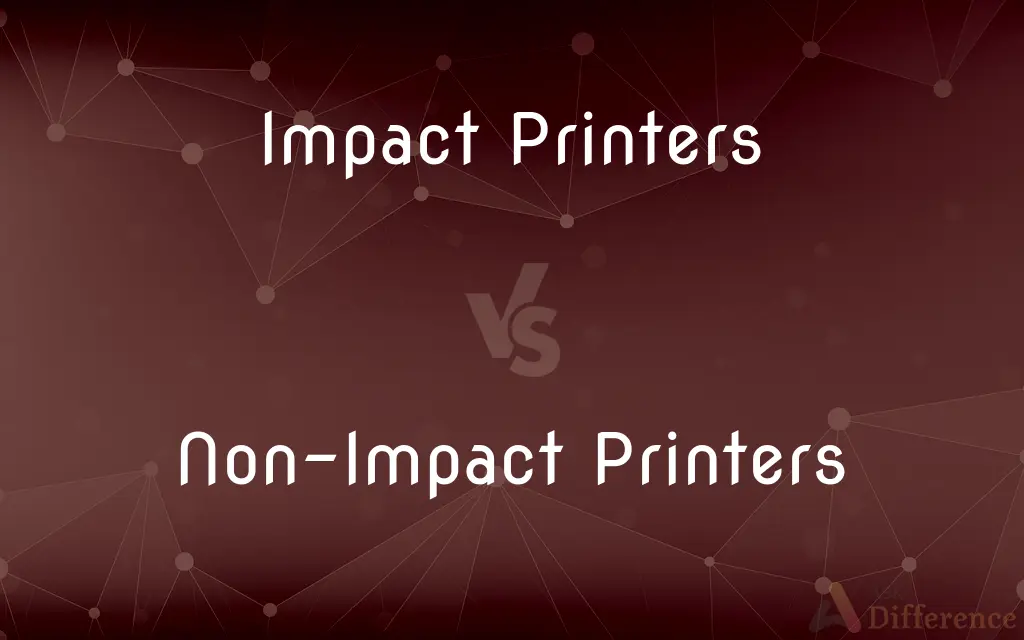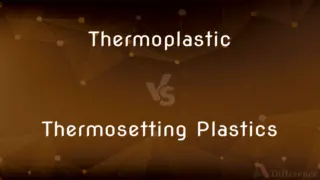Impact Printers vs. Non-Impact Printers — What's the Difference?
Edited by Tayyaba Rehman — By Fiza Rafique — Published on January 3, 2024
Impact printers strike the paper to print, making noise, while non-impact printers use non-mechanical methods, quieter and often faster.

Difference Between Impact Printers and Non-Impact Printers
Table of Contents
ADVERTISEMENT
Key Differences
Impact printers operate by physically striking a ribbon against paper, which transfers ink to create characters or images. This method is analogous to a typewriter and includes printer types such as dot matrix and daisy-wheel. Impact printers are generally noisy due to the mechanical action involved in the printing process.
Non-impact printers, on the other hand, do not require physical contact between the printing mechanism and paper. Technologies like laser and inkjet fall into this category. These printers work by depositing ink or toner onto the page using electrostatic charges, nozzles, or heat, making the process much quieter than impact printing.
The print quality of impact printers is typically lower than that of non-impact printers. Impact printers are suitable for applications where print quality is not the primary concern, such as printing multipart forms and invoices. Non-impact printers provide higher resolution prints, making them ideal for printing graphics and text where clarity and detail are important.
When it comes to speed, impact printers are generally slower due to the mechanical movement required for each character or line printed. Non-impact printers can operate at higher speeds, as they print entire pages at a time, making them more suitable for environments where high-volume printing is required.
Maintenance of impact printers involves regular replacement of ribbons and sometimes the print head itself due to wear from the impact. Non-impact printers need replacement of toner or ink cartridges and occasional cleaning of print nozzles, but typically have fewer mechanical parts to maintain or replace.
ADVERTISEMENT
Comparison Chart
Printing Mechanism
Strike ribbon against paper.
Use lasers, inkjets, or thermal methods.
Noise Level
Noisy due to mechanical impact.
Quieter, no mechanical impact noise.
Print Quality
Generally lower resolution.
Higher resolution and quality.
Speed
Slower, prints characters or lines.
Faster, prints entire pages.
Maintenance
More mechanical maintenance required.
Less maintenance, more on consumables.
Compare with Definitions
Impact Printers
Impact printers use a ribbon that is struck against paper.
Changing the ribbon in impact printers is part of regular maintenance.
Non-Impact Printers
Non-impact printers can print entire pages at once.
The report was out in minutes, thanks to the fast non-impact printer.
Impact Printers
Impact printers print individual characters with each strike.
Impact printers were clacking away at the data entry department.
Non-Impact Printers
Non-impact printers produce high-resolution output.
Our brochures are printed with a non-impact printer for crisp images.
Impact Printers
Impact printers create images through direct mechanical force.
The office's dot matrix, an impact printer, was busy printing forms.
Non-Impact Printers
Non-impact printers are often used for digital photo printing.
She printed her photos at home with a high-quality non-impact printer.
Impact Printers
Impact printers are capable of printing multi-part forms.
We use impact printers to produce carbon copies for our sales receipts.
Non-Impact Printers
Non-impact printers use ink or toner cartridges.
The non-impact printer's toner needed replacing after printing the large project.
Impact Printers
Impact printers often use continuous feed paper for printing.
The impact printer churned through a stack of continuous feed paper during the payroll run.
Non-Impact Printers
Non-impact printers operate without striking the paper.
The library's non-impact printer provided quick, silent printouts.
Common Curiosities
Do impact printers use ink cartridges?
No, they typically use ribbons and may use ink-soaked fabric or carbon film.
What are non-impact printers?
Non-impact printers use methods like inkjet or laser to print without direct contact.
Are non-impact printers better for photos?
Yes, non-impact printers generally provide higher quality and resolution, ideal for photo printing.
What are impact printers?
Impact printers create text and images by physically striking a ribbon onto paper.
How cost-effective are non-impact printers?
Non-impact printers can be cost-effective due to their speed and efficiency, especially in high-volume settings.
Do non-impact printers have a lower running cost?
This depends on the model and usage, but inkjet printers, for example, can have a higher cost per page than laser non-impact printers.
Can impact printers print in color?
Yes, some impact printers can print in color, but with limited quality compared to non-impact printers.
What kind of maintenance do non-impact printers require?
They require cartridge replacement and occasional cleaning of print heads or rollers.
Can non-impact printers print labels and stickers?
Yes, many non-impact printers are capable of printing on various media types, including labels and stickers.
Do non-impact printers require special paper?
No, they typically do not require special paper, but print quality can be improved with higher-grade paper.
Can impact printers print on multipart forms?
Yes, they are specifically designed to handle multipart forms and carbon copies.
Are impact printers suitable for office use?
They are suitable for specific tasks like printing multipart forms but may be too noisy for general office use.
Are impact printers more durable than non-impact printers?
Impact printers are mechanically robust but can wear out due to the moving parts required for printing.
What is the advantage of impact printers over non-impact printers?
Impact printers can handle continuous paper and are suitable for situations where print-through is necessary.
How does the print speed compare between the two?
Non-impact printers generally offer faster print speeds than impact printers, especially for full-page prints.
Share Your Discovery

Previous Comparison
Thermoplastic vs. Thermosetting Plastics
Next Comparison
HRM vs. Personnel ManagementAuthor Spotlight
Written by
Fiza RafiqueFiza Rafique is a skilled content writer at AskDifference.com, where she meticulously refines and enhances written pieces. Drawing from her vast editorial expertise, Fiza ensures clarity, accuracy, and precision in every article. Passionate about language, she continually seeks to elevate the quality of content for readers worldwide.
Edited by
Tayyaba RehmanTayyaba Rehman is a distinguished writer, currently serving as a primary contributor to askdifference.com. As a researcher in semantics and etymology, Tayyaba's passion for the complexity of languages and their distinctions has found a perfect home on the platform. Tayyaba delves into the intricacies of language, distinguishing between commonly confused words and phrases, thereby providing clarity for readers worldwide.














































